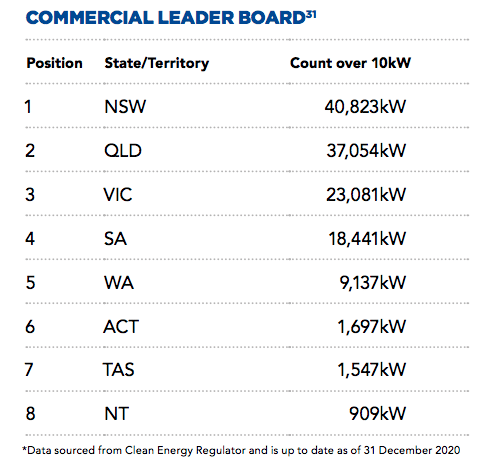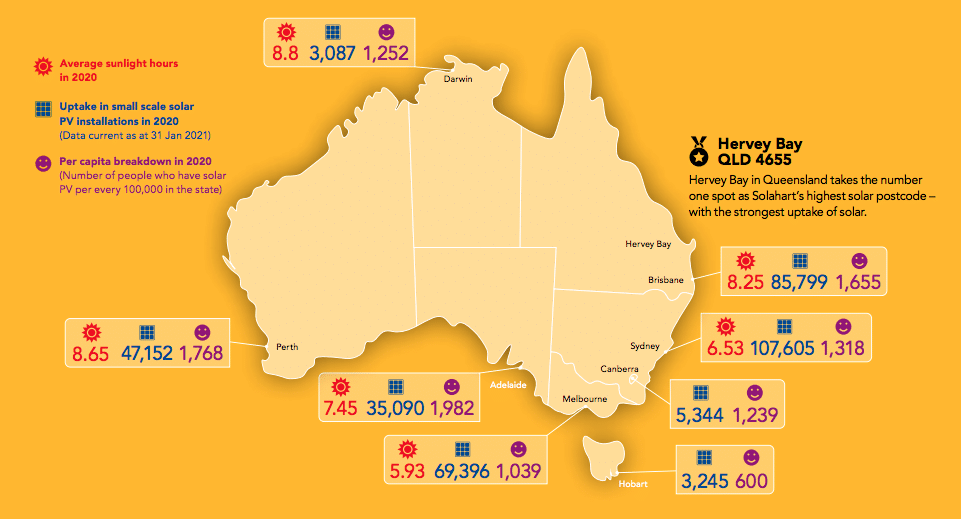Australia has the highest penetration of rooftop solar in the world, but why? Well, unsurprisingly, bills play a major role – but so too does the desire to live more sustainably.
According to research conducted by Solahart, 71% of respondents said cutting down power bills was a key priority in choosing solar power. Almost half believe solar is a necessary part of our future, while wanting to live a more sustainable lifestyle was in the top three motivators for 38% of those searching for solar power.
Australians between the ages of 45 and 54 years of age most interested in embarking on the solar journey, perhaps because they are more likely to have the capital required. Climate change is the top concern for millennials and Gen Z, though their primary aspirations were found to be travel and investing in their own homes respectively.
In terms of which regions of Australia are best suited to solar, the Northern Territory ranked at the top in terms of daylight hours (Darwin receiving 8.8 hours daily, according to the Bureau of Meteorology), but was at the bottom for rooftop solar penetration.
South Australia was ranked fourth in its daylight hours (Adelaide coming in at 7.45 hours), but was the clear winner for solar penetration. Solahart’s General Manager, Stephen Cranch, believes this exemplifies the role of policy in realising the potential of natural assets.
“The South Australian Government has had a strong environmental agenda over the last 20 years, with plenty of solar and wind resources available,” he told pv magazine Australia.
“South Australia… has led the solar PV charge from its early beginnings, well before it became a mainstream product.”
Global eyes are now on this PV pioneering state as it battles with the problem of too much renewable energy going into the grid in the middle of the day when demand is low, a phenomenon known as the duck-curve.
“The rest of the world is watching how this problem is being solved with energy storage trials like the roll out of home batteries, inverter voltage ride through requirements (curtailing solar system outputs), and the SA Smart Network, Australia’s first grid interactive smart-electric water heater program,” Cranch said.
C&I sector under-utilised
While solar PV covers 21% of Australia’s residential rooftops, far fewer Australian businesses and industrial premises have decided to harvest energy from their roofs – just 5% to be precise. It’s something Cranch notes is “surprising considering the return on investment can be very compelling.”
“Although the awareness of solar is high in Australia, with just 5% of potential rooftop space [used], more could always be done to help drive the uptake of solar technologies.

Solahart
“Many households and businesses are on the verge of making the decision to reduce their energy bills with this great renewable source, however, are hesitating as they don’t know who to trust or turn to for advice due to conflicting information from a myriad of unknown brands and companies.”
To ensure Australia’s solar wave continues, Cranch says its imperative the country extends its Renewable Energy Target, which underpins Small-scale and Large-scale Technology Certificate creation, beyond its end date in 2030.
“To ensure grid-stability as the uptake of solar continues to grow, it may be necessary for governments to incentivise the roll out of energy storage devices such as smart-electric grid-interactive water heaters,” he added.
“This would be far more cost effective than batteries and will help to soak up excess solar energy during the day rather than it being sent back to the grid. The uptake of electric vehicles (once the premium over internal combustion engine vehicles is reduced) will create more demand for solar PV particularly once bidirectional chargers are more affordable and commercially available and can interact with the energy grid.”
This content is protected by copyright and may not be reused. If you want to cooperate with us and would like to reuse some of our content, please contact: editors@pv-magazine.com.









1 comment
By submitting this form you agree to pv magazine using your data for the purposes of publishing your comment.
Your personal data will only be disclosed or otherwise transmitted to third parties for the purposes of spam filtering or if this is necessary for technical maintenance of the website. Any other transfer to third parties will not take place unless this is justified on the basis of applicable data protection regulations or if pv magazine is legally obliged to do so.
You may revoke this consent at any time with effect for the future, in which case your personal data will be deleted immediately. Otherwise, your data will be deleted if pv magazine has processed your request or the purpose of data storage is fulfilled.
Further information on data privacy can be found in our Data Protection Policy.